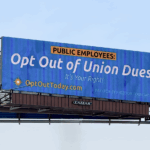If you want to know the truth about what’s happening with California’s government employee unions, ignore what their leaders say and crunch some actual numbers.
They paint an encouraging picture for taxpayers and the workers themselves but portend a bleak future for the unions.
According to the most recent data from the Bureau of Labor Statistics, California unions lost 63,000 members while the number of union-represented workers declined by 71,000 over the past year.
Union officials have a ready explanation for this — COVID-19. According to their spin, the governor’s overwrought response to the pandemic cost the state a reported 1.4 million workers during the past 10 months.
But there’s more going on here than just a shrinking economy. According to data obtained from the Sacramento Bee, SEIU 1000 — one of the state’s biggest public-sector unions — lost around 3 percent of its membership between February and November 2020.
Other unions, such as the California Teachers Association, also reported losses of several thousand members over the last year.
Note: These aren’t private-sector unions, whose members might well have been casualties of Gov. Gavin Newsom’s COVID closure stampede. These unions represented government workers — not one of whom lost a nickel due to the quarantine.
While the Freedom Foundation has reached out to both of these unions through a mixture of canvassing, physical mailers, e-mails, phone calls, and digital advertising, our own internal statistics confirm what has been reported publicly.
Take, for example, SEIU 721. Thanks to an all-out blitz from the Freedom Foundation around Christmas, more than 650 of its members opted out of union tyranny.
Both public data sets and our own internal data point to a simple fact — union membership in California is falling.
To be fair, BLS data is questionable at best and relies heavily on self-reported information from a limited number of households. It would be unfair to pretend that simply because BLS data says union membership declined that it’s an entirely accurate statement.
But coupled with other publicly available data — especially union LM-2 reports, which are released yearly (and which we expect to see many of in March of 2021), we have a pretty good idea of where union membership is headed and why it’s heading there.












